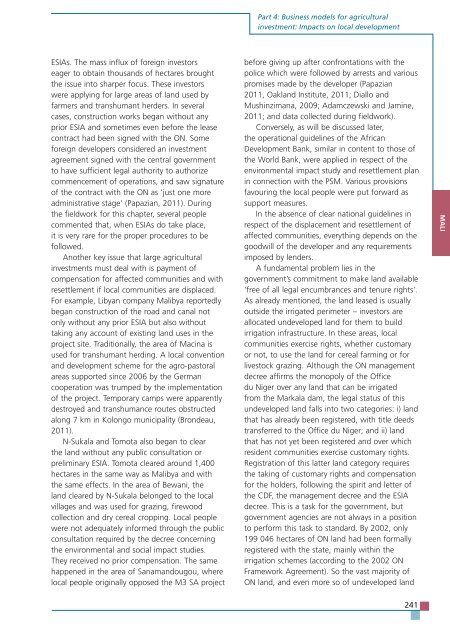TRENDS AND IMPACTS OF FOREIGN INVESTMENT IN DEVELOPING COUNTRY AGRICULTURE
TRENDS AND IMPACTS OF FOREIGN INVESTMENT IN DEVELOPING COUNTRY AGRICULTURE
TRENDS AND IMPACTS OF FOREIGN INVESTMENT IN DEVELOPING COUNTRY AGRICULTURE
You also want an ePaper? Increase the reach of your titles
YUMPU automatically turns print PDFs into web optimized ePapers that Google loves.
ESIAs. The mass influx of foreign investors<br />
eager to obtain thousands of hectares brought<br />
the issue into sharper focus. These investors<br />
were applying for large areas of land used by<br />
farmers and transhumant herders. In several<br />
cases, construction works began without any<br />
prior ESIA and sometimes even before the lease<br />
contract had been signed with the ON. Some<br />
foreign developers considered an investment<br />
agreement signed with the central government<br />
to have sufficient legal authority to authorize<br />
commencement of operations, and saw signature<br />
of the contract with the ON as ‘just one more<br />
administrative stage’ (Papazian, 2011). During<br />
the fieldwork for this chapter, several people<br />
commented that, when ESIAs do take place,<br />
it is very rare for the proper procedures to be<br />
followed.<br />
Another key issue that large agricultural<br />
investments must deal with is payment of<br />
compensation for affected communities and with<br />
resettlement if local communities are displaced.<br />
For example, Libyan company Malibya reportedly<br />
began construction of the road and canal not<br />
only without any prior ESIA but also without<br />
taking any account of existing land uses in the<br />
project site. Traditionally, the area of Macina is<br />
used for transhumant herding. A local convention<br />
and development scheme for the agro-pastoral<br />
areas supported since 2006 by the German<br />
cooperation was trumped by the implementation<br />
of the project. Temporary camps were apparently<br />
destroyed and transhumance routes obstructed<br />
along 7 km in Kolongo municipality (Brondeau,<br />
2011).<br />
N-Sukala and Tomota also began to clear<br />
the land without any public consultation or<br />
preliminary ESIA. Tomota cleared around 1,400<br />
hectares in the same way as Malibya and with<br />
the same effects. In the area of Bewani, the<br />
land cleared by N-Sukala belonged to the local<br />
villages and was used for grazing, firewood<br />
collection and dry cereal cropping. Local people<br />
were not adequately informed through the public<br />
consultation required by the decree concerning<br />
the environmental and social impact studies.<br />
They received no prior compensation. The same<br />
happened in the area of Sanamandougou, where<br />
local people originally opposed the M3 SA project<br />
Part 4: Business models for agricultural<br />
investment: Impacts on local development<br />
before giving up after confrontations with the<br />
police which were followed by arrests and various<br />
promises made by the developer (Papazian<br />
2011, Oakland Institute, 2011; Diallo and<br />
Mushinzimana, 2009; Adamczewski and Jamine,<br />
2011; and data collected during fieldwork).<br />
Conversely, as will be discussed later,<br />
the operational guidelines of the African<br />
Development Bank, similar in content to those of<br />
the World Bank, were applied in respect of the<br />
environmental impact study and resettlement plan<br />
in connection with the PSM. Various provisions<br />
favouring the local people were put forward as<br />
support measures.<br />
In the absence of clear national guidelines in<br />
respect of the displacement and resettlement of<br />
affected communities, everything depends on the<br />
goodwill of the developer and any requirements<br />
imposed by lenders.<br />
A fundamental problem lies in the<br />
government’s commitment to make land available<br />
‘free of all legal encumbrances and tenure rights’.<br />
As already mentioned, the land leased is usually<br />
outside the irrigated perimeter – investors are<br />
allocated undeveloped land for them to build<br />
irrigation infrastructure. In these areas, local<br />
communities exercise rights, whether customary<br />
or not, to use the land for cereal farming or for<br />
livestock grazing. Although the ON management<br />
decree affirms the monopoly of the Office<br />
du Niger over any land that can be irrigated<br />
from the Markala dam, the legal status of this<br />
undeveloped land falls into two categories: i) land<br />
that has already been registered, with title deeds<br />
transferred to the Office du Niger; and ii) land<br />
that has not yet been registered and over which<br />
resident communities exercise customary rights.<br />
Registration of this latter land category requires<br />
the taking of customary rights and compensation<br />
for the holders, following the spirit and letter of<br />
the CDF, the management decree and the ESIA<br />
decree. This is a task for the government, but<br />
government agencies are not always in a position<br />
to perform this task to standard. By 2002, only<br />
199 046 hectares of ON land had been formally<br />
registered with the state, mainly within the<br />
irrigation schemes (according to the 2002 ON<br />
Framework Agreement). So the vast majority of<br />
ON land, and even more so of undeveloped land<br />
241<br />
MALI


